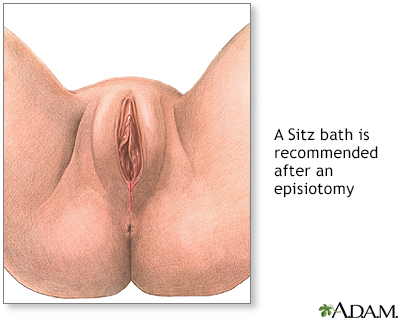Episiotomy - aftercare
Perineal laceration - aftercare; Vaginal birth perineal tear - aftercare; Postpartum care - episiotomy - aftercare; Labor - episiotomy aftercare; Vaginal delivery - episiotomy aftercare
Images

Presentation

I Would Like to Learn About:
Description
An episiotomy is a minor incision made during childbirth to widen the opening of the vagina.
A perineal tear or laceration often forms on its own during a vaginal birth. Rarely, this tear will also involve the muscle around the anus or the rectum.
Both episiotomies and perineal lacerations require stitches to repair and ensure the best healing. Both are similar in recovery time and discomfort during healing.
What to Expect
Most women heal after an episiotomy without problems, although it may take many weeks.
Your stitches do not need to be removed. Your body will absorb them. You can return to normal activities when you feel ready, such as light office work or house cleaning. Wait 6 weeks before you:
- Use tampons
- Have sexual intercourse
- Do any other activity that might rupture (break) the stitches
Self-care
To relieve pain or discomfort:
- Ask your nurse to apply ice packs right after the birth. Using ice packs in the first 24 hours after birth decreases the swelling and helps with pain.
- Take warm baths but wait until 24 hours after you have given birth. Make sure that the bathtub is cleaned with a disinfectant before every bath.
- Take medicine like acetaminophen or ibuprofen to relieve pain.
You can do many other things to help speed up the healing process, such as:
- Use sitz baths (sit in water that covers your vulvar area) a few times a day. Wait until 24 hours after you have given birth to take a sitz bath as well. You can buy tubs in any drug store that will fit on the rim of the toilet. If you prefer, you can sit in this kind of tub instead of climbing into the bathtub.
- Change your pads every 2 to 4 hours.
- Keep the area around the stitches clean and dry. Pat the area dry with a clean towel after you bathe.
- After you urinate or have a bowel movement, spray warm water over the area and pat dry with a clean towel or baby wipe. Do not use toilet paper.
Take stool softeners and drink lots of water. This will prevent constipation. Eating lots of fiber will also help. Your health care provider can suggest foods with plenty of fiber.
Do Kegel exercises. Squeeze the muscles that you use to hold in urine for 5 minutes. Do this 10 times a day throughout the day.
When to Call the Doctor
Contact your provider if:
- Your pain gets worse.
- You go for 4 or more days without a bowel movement.
- You pass a blood clot larger than a walnut.
- You have a discharge with a bad odor.
- The wound seems to break open.
References
Baggish MS. Episiotomy. In: Baggish MS, Karram MM, eds. Atlas of Pelvic Anatomy and Gynecologic Surgery. 5th ed. Philadelphia, PA: Elsevier; 2021:chap 78.
Kilatrick SJ, Garrison E, Fairbrother E. Normal labor and delivery. In: Landon MB, Galan HL, Jauniaux ERM, et al, eds. Gabbe's Obstetrics: Normal and Problem Pregnancies. 8th ed. Philadelphia, PA: Elsevier; 2021:chap 11.
BACK TO TOPReview Date: 5/14/2024
Reviewed By: John D. Jacobson, MD, Professor Emeritus, Department of Obstetrics and Gynecology, Loma Linda University School of Medicine, Loma Linda, CA. Also reviewed by David C. Dugdale, MD, Medical Director, Brenda Conaway, Editorial Director, and the A.D.A.M. Editorial team.

Health Content Provider
06/01/2025
|
A.D.A.M., Inc. is accredited by URAC, for Health Content Provider (www.urac.org). URAC's accreditation program is an independent audit to verify that A.D.A.M. follows rigorous standards of quality and accountability. A.D.A.M. is among the first to achieve this important distinction for online health information and services. Learn more about A.D.A.M.'s editorial policy, editorial process and privacy policy. A.D.A.M. is also a founding member of Hi-Ethics. This site complied with the HONcode standard for trustworthy health information from 1995 to 2022, after which HON (Health On the Net, a not-for-profit organization that promoted transparent and reliable health information online) was discontinued. |
The information provided herein should not be used during any medical emergency or for the diagnosis or treatment of any medical condition. A licensed medical professional should be consulted for diagnosis and treatment of any and all medical conditions. Links to other sites are provided for information only -- they do not constitute endorsements of those other sites. © 1997- 2025 A.D.A.M., a business unit of Ebix, Inc. Any duplication or distribution of the information contained herein is strictly prohibited.
